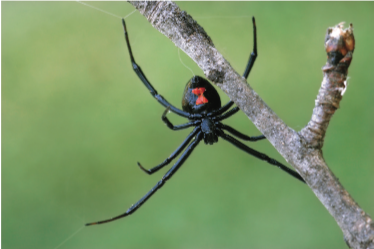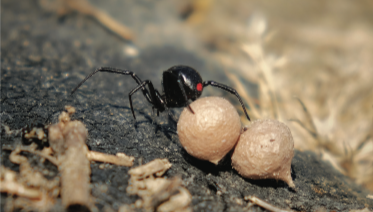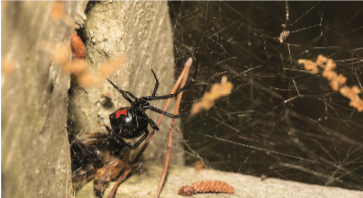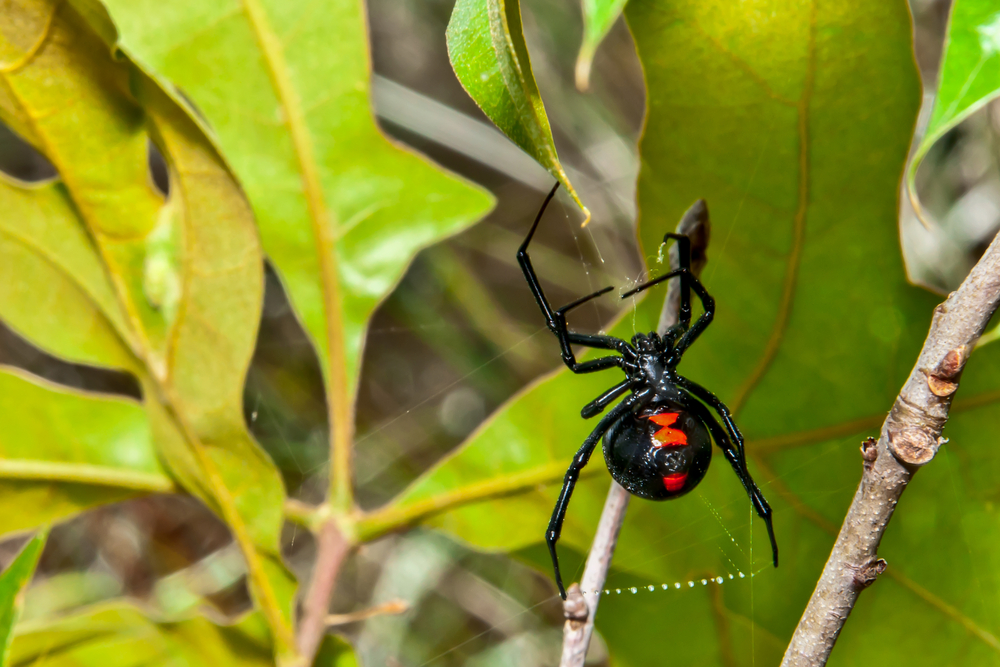Home

People are often afraid of spiders because of their ill-deserved reputation for envenomizing victims. In fact, most spiders do not have mouth- parts strong enough to penetrate skin.
Spiders are considered beneficial arthropods because they often prey on insects that we consider nuisances. Therefore, homeowners should be encouraged to leave spiders alone if the spiders are in their natural habitats, such as gardens or yards. However, the black widow spider (Latrodectus mactans) is an exception.

Figure 1. Black widow spider with red hourglass on abdomen
Description
The black widow female is most easily recognized by her shiny black body and red, hourglass marking on the underside of her abdomen (Figure 1). The red marking can also be two separate spots of red.
Females range in size from 5.0 to 13.5 mm (0.20 to 0.50 inches). Males range in size from 3.0 to 5.0 mm (0.12 to 0.20 inches), are completely black, and are seldom seen.
Colors of immature spiders vary. Newly hatched spiders, known as spiderlings, are yellowish white and acquire more black and red with each molt.
Life Cycle
The average egg sac is spherical and 9.5 mm (0.37 inch) in diameter (Figure 2). It contains an average of 255 eggs. The black widow female often produces several egg sacs. The young spiders emerge from the egg sac after an incubation period of 26 to 30 days, usually during the spring (Table 1). Spiderlings are then dispersed to different geographic areas through “ballooning.”

Figure 2. Dorsal view of a black widow female with egg sacs
Males reach maturity after 54 to 88 days. Females reach maturity after 112 to 140 days. Many young will be eaten by predators and by their own siblings.
Adult females generally live for 1 year while males live for about 4 months. Adult females can live without food for an average of 90 days.
Table 1. Life Stages and Seasons of the Black Widow in the Southeastern United States
| Stage | Season most visible |
|---|---|
| Egg sac | Late fall, winter. White to tan in color. Suspended in the web. |
| Spiderlings | Overwinter and are retained in late season egg sacs until spring when they emerge. Spiderlings continue to grow into adults during the spring and summer. |
| Adults | Mature by mid to late summer. Adults are most prevalent during late summer and fall. Some adult females will live through winter and produce multiple egg sacs although most of the spiderlings will die during hard freezes. |
The Web and Behavior
The web of the black widow spider is an irregular, tangled mesh of threads when compared with the symmetrical webs of the orb-weaving spiders commonly seen around homes and gardens. The black widow spider is shy and nocturnal, usually hanging on the web belly upward. However, black widows are more aggressive if they are protecting an egg sac. They usually can be induced to bite only if pressed against the skin.

Habitat
Black widows are usually found outdoors. Webs are normally built in dark, quiet, and undisturbed areas, such as under rocks and debris, in woodpiles, or under or around houses. Cold weather and drought may drive these spiders into buildings. In man-made habitats, they can be found in barns, cellars, garages, storage sheds, crawl spaces, rain spouts, weep holes, furniture, park benches, and in water, gas, and electrical boxes.
The Bite
Only female black widows bite; males and juveniles of both sexes do not bite. Bites occur only when a human traps the spider against flesh. When a person is bitten, a neurotoxin is introduced with the saliva that causes a dull pain and cramping in muscles. These symptoms can be accompanied by sweating and vomiting. Pain reaches its maximum between 1 and 3 hours and generally subsides in 12 to 24 hours.
People rarely die from the bite. Children who weigh less than 30 pounds are at greatest risk.
First Aid
First aid for someone who has been bitten by a black widow can include the following.
- Clean the wound using mild soap and water and apply an antibiotic ointment to prevent infection.
- Use a cool compress or ice pack to reduce the swelling in the area surrounding the bite.
- Your doctor may recommend a tetanus booster shot if you haven’t had one in the last five years.
Control
An Integrated Pest Management (IPM) approach is the best means of control. IPM incorporates all available control methods into a pest management program. Nonchemical methods are the primary control technique. When working around areas where black widow spiders may be established, take proper precautions and wear gloves and boots.
Sanitation
If black widows are found, the premises should be thoroughly inspected to determine breeding areas in and around buildings. Remove any spiders, webs, and egg sacs by vacuuming. When emptying the vacuum bag, leave the motor running while sealing the bag. This avoids polluting the air with dust and the possible escape of some spiders. Dispose of the bag outside. Black widows can also be cleaned out of an area simply by knocking them down with a stick or broom and crushing them underfoot.
Exclusion
Remove materials around houses where black widows might hide. Seal cracks and crevices in the structure where spiders can come in. Common areas for cracks and crevices are windowsills, door thresholds, and around pipes. Installing tight-fitting screens on attic and foundation vents is also important.

Chemical
Judiciously use pesticides labeled for spider control for serious black widow infestations. Use a pyrethroid or other labeled pesticide to spot treat corners and other sites where spiders have built or might construct webs in a house and dust crawl spaces. Many pesticides are labeled for spider control. Some are labeled for homeowner use, while others are labeled only for licensed or certified pest control professionals. Follow all instructions on the product label.
Enlisting the services of a professional pest control operator is an option to be seriously considered for black widow infestations.
Myths and Curious Facts
- Female spiders always eat the male after mating, hence the name “widow.”
- Contrary to this popular belief, the male is seldom devoured by the female after mating. Instead, the male usually disengages from the female quickly and lingers nearby, living as a “parasite” by feeding on prey captured by the female.
- Black widows will bite aggressively when being disturbed.
- Black widows are generally not aggressive. They will typically retreat to a corner of their webs when disturbed. They are more aggressive if they are protecting an egg sac and bite only if pressed against human skin.
- A bite by a black widow is comparable to a bite by a rattlesnake.
- Although the venom of the black widow spider is 15 times as toxic as the venom of the prairie rattlesnake, a single bite by a black widow is rarely fatal because only a minute amount of the toxin is injected.
- Only the female black widow is venomous; males and juveniles are harmless.
- Only females bite and inject venom. However, spiderlings contain a poisonous substance in their body tissue until they are 18 days old and can be especially toxic if ingested by pets and children. Spiderling toxin is different from the adult female venom.
Another interesting fact about the black widow is that its web is extraordinarily strong. It has been known to snare animals as large as mice. Web threads are also used for crosshairs in rifle sights.

